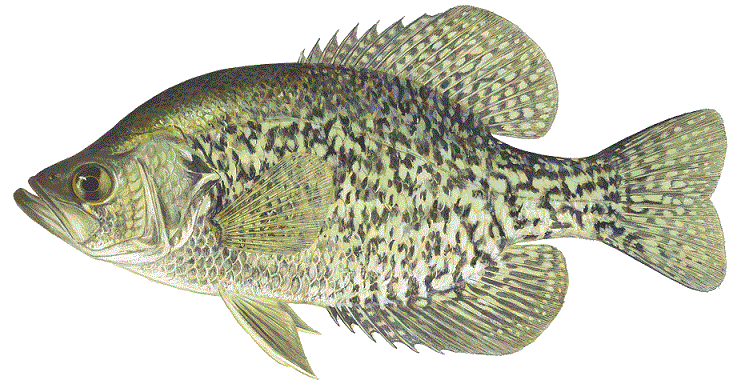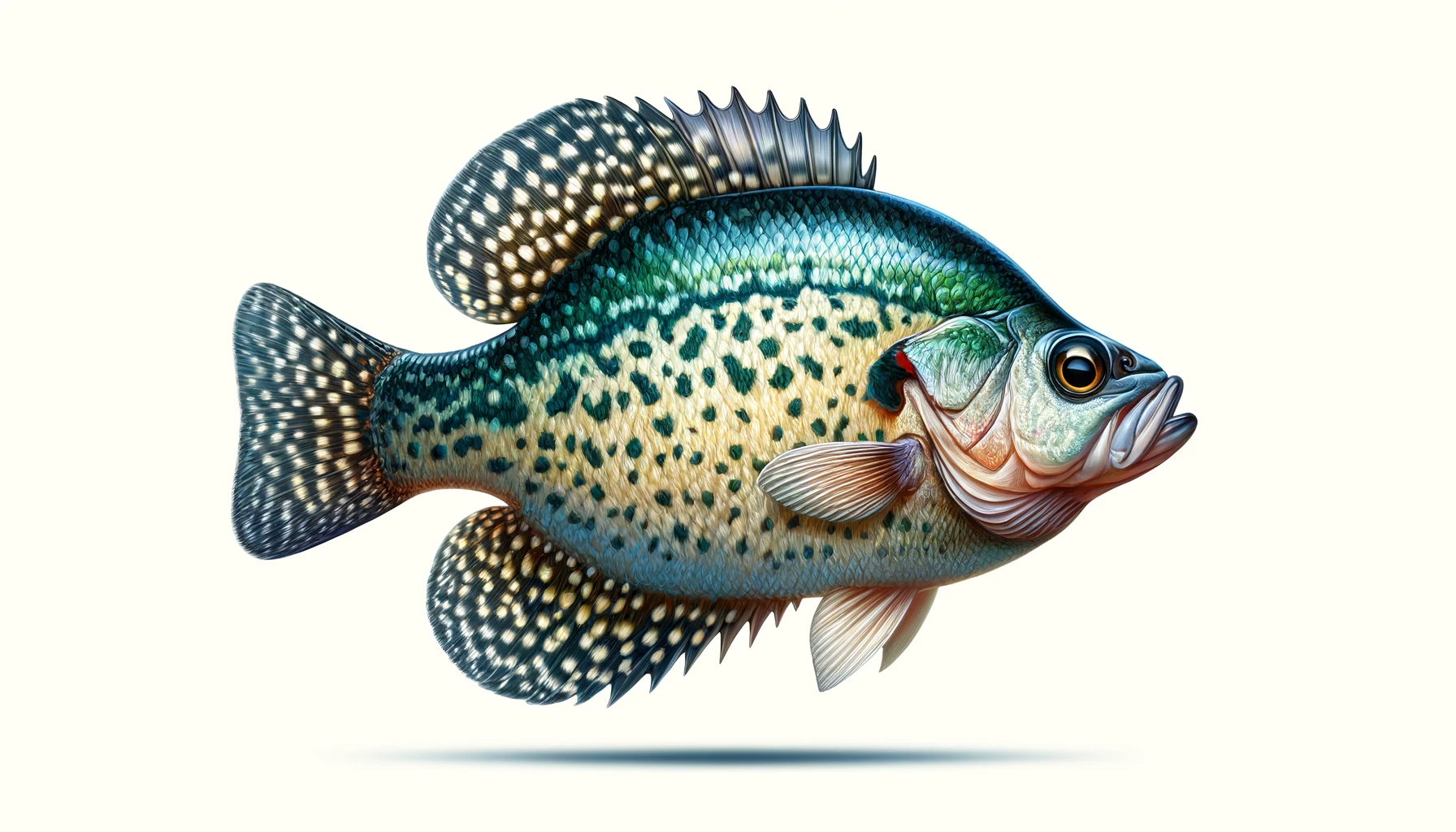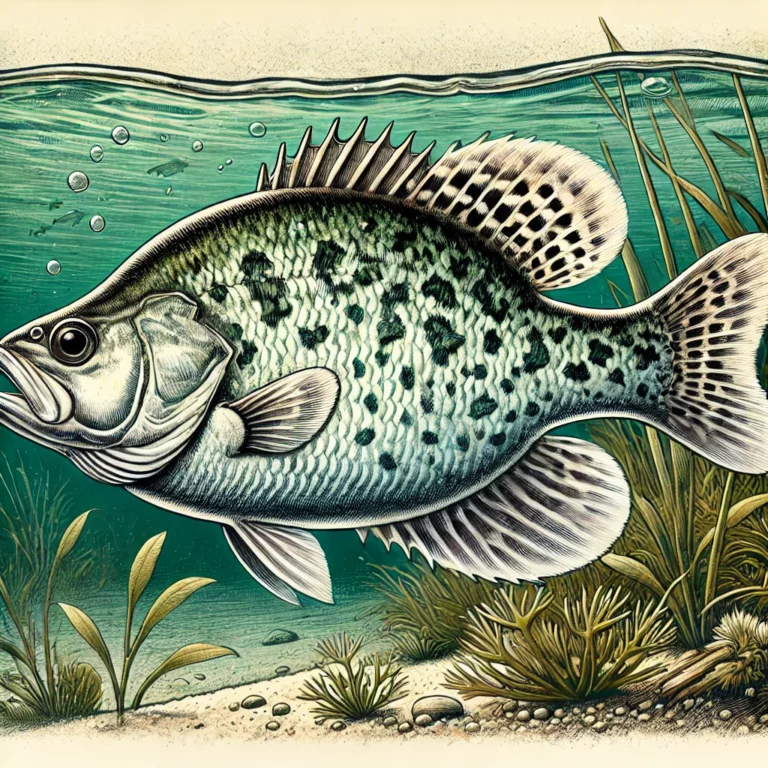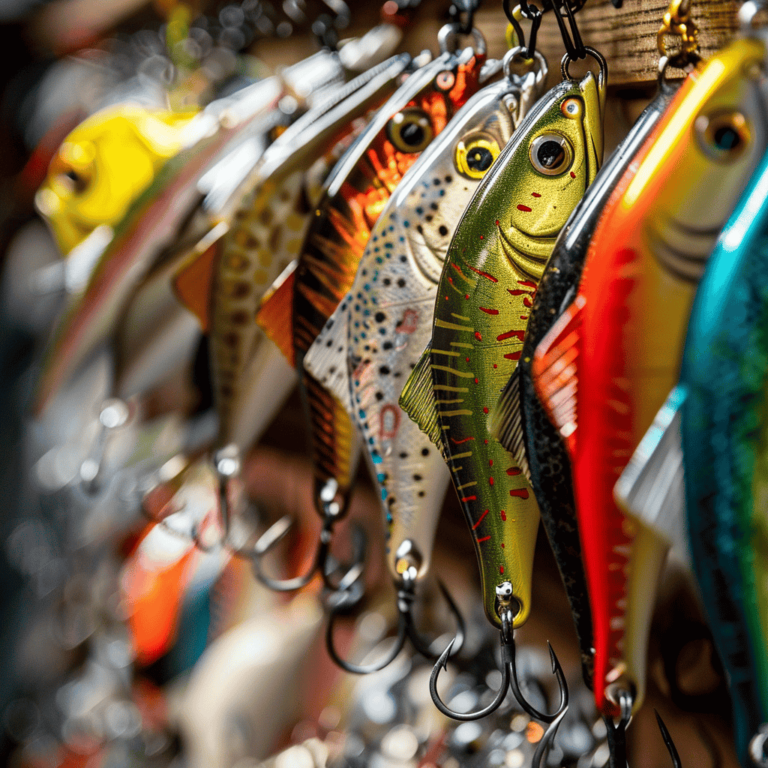Crappie Fishing: The Ultimate Guide to Catching Panfish
This guide is about one of the most beloved panfish in North America: crappie.
The word panfish, also spelled pan-fish or pan fish, is an American English term describing any edible freshwater fish that usually do not outgrow the size of an average frying pan.
Wikipedia
Whether you’re a seasoned angler or just starting out, crappie fishing offers something for everyone.
Known for their delicious taste and the thrill of the catch, crappie are a favorite target for many fishermen.
So, grab your rods and reels, and let’s learn about crappie fishing.
Understanding Crappie: The Basics
Crappie come in two main species: black crappie and white crappie.
Both are prized catches, but they have some differences that are worth noting.
Black Crappie: These fish prefer clearer, deeper waters with plenty of vegetation. They have a more pronounced mottled pattern on their bodies, which can help you distinguish them from their white cousins.

(image source: iowadnr.gov)
White Crappie: These fish are more tolerant of murky water and can often be found in shallower waters. They have a more uniform silver color with faint vertical bars running down their sides.

(image source: iowadnr.gov)
Both species are known for their paper-thin mouths, which can be both a blessing and a curse.
It means they can be easily hooked, but you need to be gentle when reeling them in to avoid tearing the hook out.
Why Crappie Fishing?
Crappie fishing is popular for several reasons:
- Accessibility: Crappie are found in lakes, rivers, reservoirs, and ponds across much of North America. This makes them accessible to a wide range of anglers, whether you’re fishing from a boat, a dock, or the shore.
- Taste: Crappie are known for their delicious, flaky white meat. They’re a favorite for fish fries and other culinary delights.
- Challenge and Reward: While crappie can be relatively easy to catch, they can also be finicky and require a bit of strategy. This balance of challenge and reward keeps anglers coming back for more.
- Family-Friendly: Crappie fishing is a great activity for families. The action can be fast-paced, keeping kids engaged and excited.
Gear and Tackle for Crappie Fishing
Let’s talk about the gear you’ll need to get started.
The good news is that crappie fishing doesn’t require a lot of expensive equipment.
Rod and Reel
A light to ultralight spinning rod and reel combo is perfect for crappie fishing.
Look for a rod that’s about 6 to 7 feet long, with a sensitive tip to detect those subtle bites.
Line
Light line is key for crappie fishing.
Use 2 to 6-pound test line to give you the sensitivity you need without spooking the fish.
Hooks
Crappie have delicate mouths, so small, sharp hooks are a must.
Use size 4 to 8 hooks, depending on the size of the bait you’re using.
Bobbers and Floats
Slip bobbers or small floats can help you present your bait at the right depth.
They’re also great for detecting those gentle crappie bites.
Jigs and Plastics
Jigs are a staple in crappie fishing.
A variety of colors and sizes can be effective, but 1/16 to 1/8 ounce jigs are a good starting point.
Pair them with soft plastic baits like tubes, grubs, or minnow imitations.
Live Bait
Minnows are the go-to live bait for crappie.
Small worms or crickets can also be effective.
Finding Crappie: Seasonal Patterns
Knowing where to find crappie is half the battle.
Their location can vary greatly depending on the season, so let’s break it down:
Spring
Spring is prime time for crappie fishing.
As the water warms up, crappie move into shallow areas to spawn.
Look for them around submerged vegetation, brush piles, and shallow coves.
During the spawn, they can be found in water as shallow as 1 to 3 feet.
Summer
As the water heats up in the summer, crappie move to deeper, cooler water.
They’ll often suspend around submerged structures like brush piles, fallen trees, and drop-offs.
Look for them in 10 to 20 feet of water, depending on the depth of your lake.
Fall
In the fall, crappie become more active as the water cools down.
They move back into shallower waters to feed heavily in preparation for winter.
Focus on mid-depth structures, like points and weed edges, in 5 to 15 feet of water.
Winter
In winter, crappie can be found in deeper water, often near the bottom.
They’ll school up tightly, so once you find one, you’re likely to find more.
Use your electronics to locate these schools and target them with vertical presentations.

Techniques for Catching Crappie
Now that you know where to find crappie, let’s talk about how to catch them. Here are some tried-and-true techniques:
Jigging
One of the most effective ways to catch crappie is by jigging.
Cast your jig near structures like brush piles, docks, or submerged trees.
Let it sink to the desired depth, then use a slow, steady retrieve with occasional twitches to entice the fish.
Vertical jigging is also effective, especially in deeper water.
Spider Rigging
This technique is popular among boat anglers.
It involves using multiple rods spread out from the boat, each with a different bait or jig.
Slowly troll or drift through likely crappie spots, covering a wide area.
This method is great for locating schools of crappie.
Slip Bobber Fishing
Slip bobbers allow you to present your bait at a specific depth, making them ideal for crappie fishing.
Set your bobber stop to the desired depth, cast out, and let the bait settle.
Watch the bobber closely for any movement, as crappie bites can be subtle.
Casting and Retrieving
If crappie are active, casting and retrieving small jigs or crankbaits can be very effective.
Use a slow, steady retrieve with occasional pauses to mimic the movement of baitfish.
Night Fishing
Crappie are known to feed actively at night, especially during the warmer months.
Use a light to attract baitfish, which in turn will attract crappie.
Fish with live minnows or glow-in-the-dark jigs for the best results.
Tips and Tricks for Success
Crappie fishing can be incredibly rewarding, but it also requires some finesse and know-how.
Here are some tips and tricks to help you succeed:
Pay Attention to Water Temperature
Crappie behavior is heavily influenced by water temperature.
Use a thermometer to check the water temperature and adjust your fishing strategy accordingly.
Use Light Tackle
Crappie have delicate mouths, so light tackle is essential.
Use a sensitive rod and light line to feel those subtle bites and avoid tearing the hook out.
Experiment with Colors
Crappie can be finicky about color, so don’t be afraid to experiment.
Bright colors like chartreuse, pink, and white are often effective, but sometimes natural colors like shad or bluegill patterns work best.
Fish Slow and Steady
Crappie bites can be subtle, so fish with a slow, steady retrieve.
Avoid jerky or fast movements that can spook the fish.
Be Patient
Crappie fishing often requires patience.
If you’re not getting bites, try changing your depth, location, or bait.
Sometimes small adjustments can make a big difference.
Keep Your Hooks Sharp
Sharp hooks are crucial for hooking crappie.
Check your hooks regularly and sharpen or replace them as needed.
Conservation and Ethical Practices
As with all fishing, it’s important to practice conservation and ethical angling when targeting crappie.
Here are some guidelines to follow:
Follow Regulations
Always check and follow local fishing regulations, including size, bag, and slot limits.
These rules are in place to ensure sustainable fish populations.
Handle Fish Carefully
When handling crappie, wet your hands before touching them to protect their slime coat.
Use a dehooking tool to minimize injury, and release fish as quickly as possible.
Minimize Impact
Be mindful of your impact on the environment.
Avoid disturbing vegetation and wildlife, and always pack out any trash or litter.
Crappie Recipes: From the Lake to the Table
One of the best parts of crappie fishing is enjoying your catch at the dinner table.
Here are a few simple and delicious crappie recipes to try:
Classic Fried Crappie
Ingredients:
- 1 lb crappie fillets
- 1 cup flour
- 1 cup cornmeal
- 1 tsp salt
- 1/2 tsp black pepper
- 1/2 tsp paprika
- 1/4 tsp garlic powder
- Oil for frying
Instructions:
- Mix the flour, cornmeal, salt, pepper, paprika, and garlic powder in a shallow dish.
- Dredge the crappie fillets in the mixture, coating them evenly.
- Heat oil in a large skillet over medium-high heat.
- Fry the fillets for 2-3 minutes per side, until golden brown and crispy.
- Remove from the oil and drain on paper towels. Serve hot with your favorite dipping sauce.
Baked Parmesan Crappie
Ingredients:
- 1 lb crappie fillets
- 1/4 cup grated Parmesan cheese
- 1/4 cup breadcrumbs
- 1/4 tsp salt
- 1/4 tsp black pepper
- 1/4 tsp paprika
- 2 tbsp melted butter
- Lemon wedges for serving
Instructions:
- Preheat your oven to 375°F (190°C).
- In a bowl, mix the Parmesan cheese, breadcrumbs, salt, pepper, and paprika.
- Brush the crappie fillets with melted butter, then coat them with the breadcrumb mixture.
- Place the fillets on a baking sheet lined with parchment paper.
- Bake for 15-20 minutes, until the fish is cooked through and the topping is golden brown.
- Serve with lemon wedges and a side salad for a healthy and delicious meal.
Grilled Crappie Tacos
Ingredients:
- 1 lb crappie fillets
- 2 tbsp olive oil
- 1 tsp chili powder
- 1/2 tsp cumin
- 1/2 tsp garlic powder
- 1/2 tsp salt
- 1/4 tsp black pepper
- Corn or flour tortillas
- Toppings: shredded cabbage, diced tomatoes, sliced avocado, lime wedges, cilantro, sour cream, salsa
Instructions:
- Preheat your grill to medium-high heat.
- In a small bowl, mix the olive oil, chili powder, cumin, garlic powder, salt, and pepper.
- Brush the crappie fillets with the seasoning mixture.
- Grill the fillets for 3-4 minutes per side, until cooked through and flaky.
- Remove from the grill and let rest for a few minutes.
- Warm the tortillas on the grill for a few seconds on each side.
- Assemble the tacos with grilled crappie and your favorite toppings.
- Serve with lime wedges and enjoy!
Conclusion: Embrace the Thrill of Crappie Fishing
Crappie fishing is a rewarding and enjoyable pastime that offers something for everyone.
Whether you’re looking to fill your cooler with tasty fish or enjoy a relaxing day on the water, crappie fishing delivers.
Armed with this knowledge, and these techniques, you can successfully target these panfish year-round.
Remember to respect the waters, practice ethical angling, and have fun.
The thrill of crappie fishing is not just in the catch, but in the experience of being out on the water, connecting with nature, and creating memories with family and friends.
And don’t forget to share your crappie fishing stories and recipes with your fellow anglers.
Tight lines and happy fishing!



